Study on Influencing Factors of Temperature Variation Displacement Compensation Behavior of Gas Insulated Switchgear Shell Bellows
Abstract
:1. Introduction
2. Influencing Factors of Displacement Compensation Behavior of GIS Shell Bellows
2.1. Structural Dimensions of Shell Bellows
2.2. Coaxiality of Shells on Both Sides of Bellows
2.3. Arrangement of Shell Bellows
3. Simulation Modeling of Shell Bellows’ Displacement Based on ABAQUS Soft
3.1. Simulation Model Establishment and Contact Setting
3.2. Material Property Settings
3.3. Boundary Constraints and Load Setting
3.4. Meshing
4. Case Simulation Data Analysis and Discussion
4.1. Simulation Results of Structural Dimensions of Shell Bellows
- (a)
- Wall thickness of bellows
- (b)
- Wave height of bellows
4.2. Simulation Results of Coaxiality of Shells on Both Sides of Bellows
4.3. Arrangement of Shell Bellows
4.4. Discussion
5. Conclusions
- The temperature-dependent displacement compensation behavior of the GIS shell bellows is related to their own structural size, GIS shell shape, and layout. The influence of the bellows’ structural size is the most significant, the influence of GIS shell shape is ranked second, and the influence of layout is the least significant.
- Within the scope allowed by the design standard, bellows with thin walls and large wave height should be selected. This can effectively improve the temperature variation displacement compensation ability of the bellows and reduce the stress concentration in the compensation process. When the wave height of the bellows is increased, their compensation capacity increases by about 5% and the maximum stress value decreases by about 3%. When the wall thickness of the bellows is reduced, their compensation capacity increases by about 26% and the maximum stress value decreases by about 4%. The influence of the wall thickness is more significant than that of the wave height.
- Within the temperature variation range of daily work, the compensation capacity of distributed bellows is better than that of centralized bellows, and can alleviate the initial deformation caused by gravity and gas pressure in GIS equipment. In this case, the initial shape variable of distributed bellows is only 80% of that of centralized bellows.
- The influence of the shell shape on the temperature variation displacement compensation ability of the bellows mainly relates to changing the friction between the sliding support leg and the base. When the base of the sliding support leg is lower than the base of the fixed support leg, the temperature variation displacement compensation of the bellows increases, whereas the temperature compensation ability of the bellows increases. However, both cases are not conducive to alleviating the phenomenon of stress concentration. In the case study, the maximum stress is increased by 1.42 times compared with the stress value of the axis of the shell is horizontal.
- The geometry of the GIS equipment shell has an impact not only on the temperature change displacement compensation ability of the bellows, but also on their own temperature change behavior. The next work will focus on the temperature change behavior of GIS equipment under the coupling of the geometry of the bellows and the shell.
Author Contributions
Funding
Institutional Review Board Statement
Informed Consent Statement
Data Availability Statement
Conflicts of Interest
References
- Liu, Z.; Wang, C.; Lu, S.; Sun, G.; Wang, N.; Li, P.; Yu, Z.; Zhang, P. Key technical requirements of UHV Gil for Sutong utility tunnel project. Power Grid Technol. 2020, 44, 2377–2385. [Google Scholar]
- Wang, Z.; Gao, J.; Wang, R.; Chen, K.; Gao, Z.; Jiang, Y. Failure mode and effects analysis using Dempster-Shafer theory and TOPSIS method: Application to the gas insulated metal enclosed transmission line (GIL). Appl. Soft Comput. 2018, 70, 633–647. [Google Scholar] [CrossRef]
- Cong, H.; Jin, H. Research on Undetected Overheat Fault of the GIS Bus Bar Contacts Based on Infrared Thermal Imaging. J. Electr. Eng. Technol. 2019, 14, 839–848. [Google Scholar] [CrossRef]
- General Office of State Grid Corporation of China. Anti Accident Measures and Fault Analysis Report on Expansion Joint of Outdoor GIS Equipment; General Office of State Grid Corporation of China: Beijing, China, 2015. [Google Scholar]
- Fang, H.; Tan, P.; Du, X.; Li, B.; Yang, K.; Zhang, Y. Numerical and Experimental Investigation of the Effect of Traffic Load on the Mechanical Characteristics of HDPE Double-Wall Corrugated Pipe. Appl. Sci. 2020, 10, 627. [Google Scholar] [CrossRef] [Green Version]
- You, Q.; Miao, L.; Dong, D. Analysis of mechanical properties of steel bellows. J. Southeast Univ. (Nat. Sci. Ed.) 2017, 47, 1187–1194. [Google Scholar]
- Kunpeng, W.E.I.; Xingjian, D.A.I.; Zongyi, S.H.A.O. Measurement and finite element analysis of bending stiffness of carbon fiber bellows. J. Tsinghua Univ. (Nat. Sci. Ed.) 2019, 59, 587–592. [Google Scholar]
- Fang, H.; Tan, P.; Du, X.; Li, B.; Yang, K.; Zhang, Y. Mechanical response of buried HDPE double-wall corrugated pipe under traffic-sewage coupling load. Tunn. Undergr. Space Technol. 2021, 108, 103664. [Google Scholar] [CrossRef]
- Sellappan, A.; Chandrasekharan, M.; More, S.; Kamble, D.; Janghel, D. Reliable design of bellows and end components for vacuum interrupters having longer stroke length. In Proceedings of the 2014 International Symposium on Discharges and Electrical Insulation in Vacuum, Mumbai, India, 28 September–3 October 2014; pp. 477–480. [Google Scholar]
- Hong, L.; Ai, S.; Xie, H.; Du, W.; Yao, X.; Zhang, B.; Liu, P.; Liu, Z.; Wang, J.; Geng, Y.; et al. Fatigue life simulation of vacuum interrupter bellows subjected to high gas pressure and high operating velocity. In Proceedings of the 2017 4th International Conference on Electric Power Equipment—Switching Technology, Xi’an, China, 22–25 October 2017; pp. 633–636. [Google Scholar]
- Chen, T.; Su, M.; Pan, C.; Zhang, L.; Wang, H. Local buckling of corrugated steel plates in buried structures. Thin-Walled Struct. 2019, 144, 106348. [Google Scholar] [CrossRef]
- Zinovieva, T.V.; Smirnov, K.K.; Belyaev, A.K. Stability of corrugated expansion bellows: Shell and rod models. Acta Mech. 2019, 230, 4125–4135. [Google Scholar] [CrossRef]
- Yuan, Z.; Huo, S.; Ren, J. Mathematical description and mechanical characteristics of reinforced S-shaped bellows. Int. J. Press. Vessel. Pip. 2019, 175, 103931. [Google Scholar] [CrossRef]
- Tomarov, G.V.; Shipkov, A.A. Bellows Expansion Joints of the Main Heating Network Pipelines: Problems and Damage Prevention. Therm. Eng. 2019, 66, 367–371. [Google Scholar] [CrossRef]
- GB/T-16749-2018; Pressure Vessel Wavy Expansion Joint. National Standardization Administration of China: Beijing, China, 2018.
- State Grid Corporation of China. Technical Standard for Gas Insulated Metal Enclosed Switchgear; China Electric Power Press: Beijing, China, 2012. [Google Scholar]
- GB/T 30092-2013; Metal Bellows Compensator for High Voltage Switchgear. National Standardization Administration of China: Beijing, China, 2013.
- Zhang, D.W.; Shi, T.L.; Zhao, S.D. Through-Process Finite Element Modeling for Warm Flanging Process of Large-Diameter Aluminum Alloy Shell of Gas Insulated (Metal-Enclosed) Switchgear. Materials 2019, 12, 1784. [Google Scholar] [CrossRef] [PubMed] [Green Version]
- Zebouchi, N.; Haddad, M.A. A Review on Real-Size Epoxy Cast Resin Insulators for Compact High Voltage Direct Current Gas Insulated Switchgears and Gas Insulated Transmission Lines—Current Achievements and Envisaged Research and Development. Energies 2020, 13, 6414. [Google Scholar] [CrossRef]
- Kim, J.K.; Hahn, S.C.; Park, K.Y.; Kim, H.K.; Oh, Y.H. Temperature rise prediction of EHV GIS bus bar by coupled magnetothermal finite element method. IEEE Trans. Magn. 2005, 41, 1636–1639. [Google Scholar]
- State Grid Corporation of China. Process Standard Library of Power Transmission and Transformation Engineering of State Grid Corporation of China; Electric Power Press: Beijing, China, 2012. [Google Scholar]
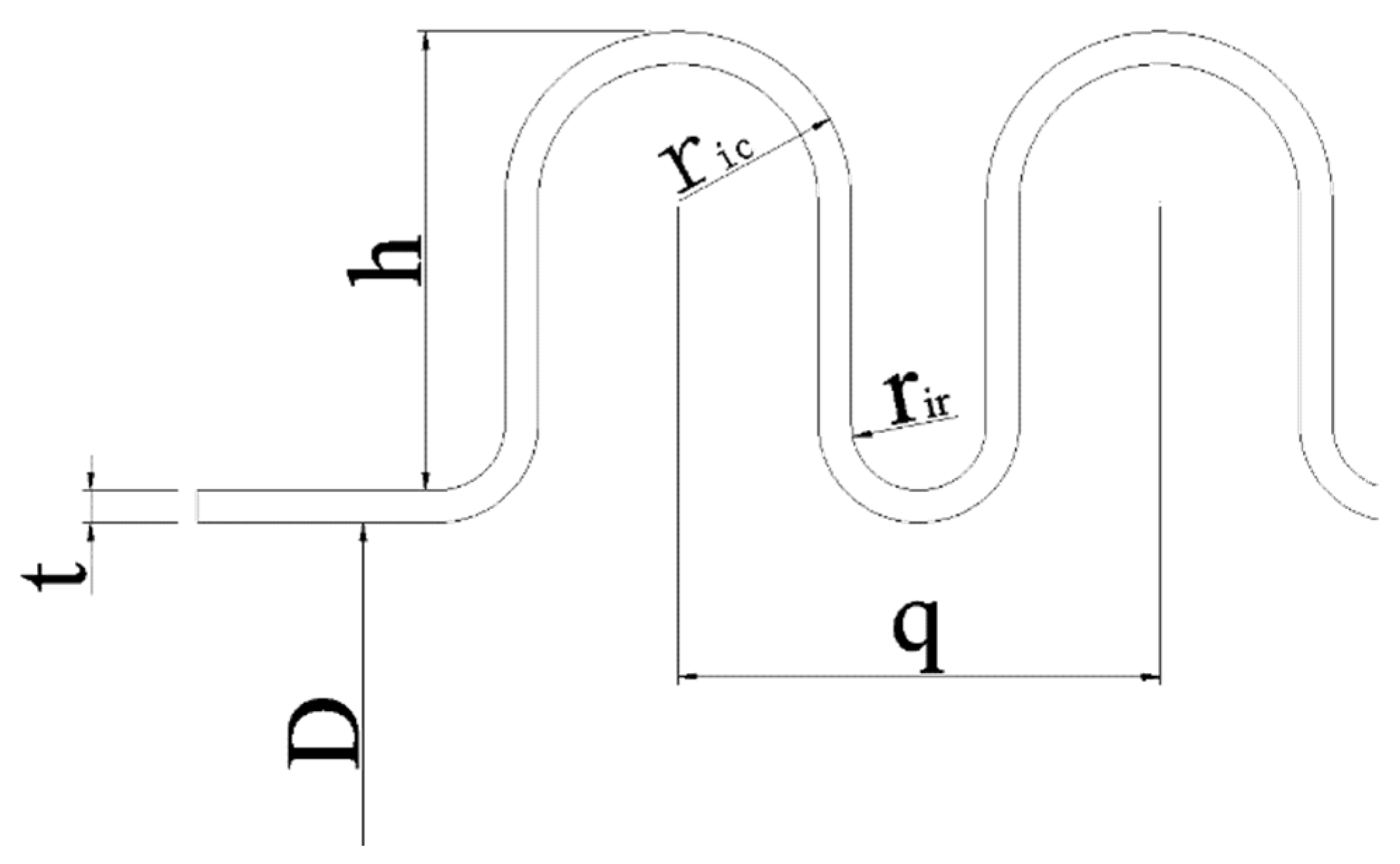

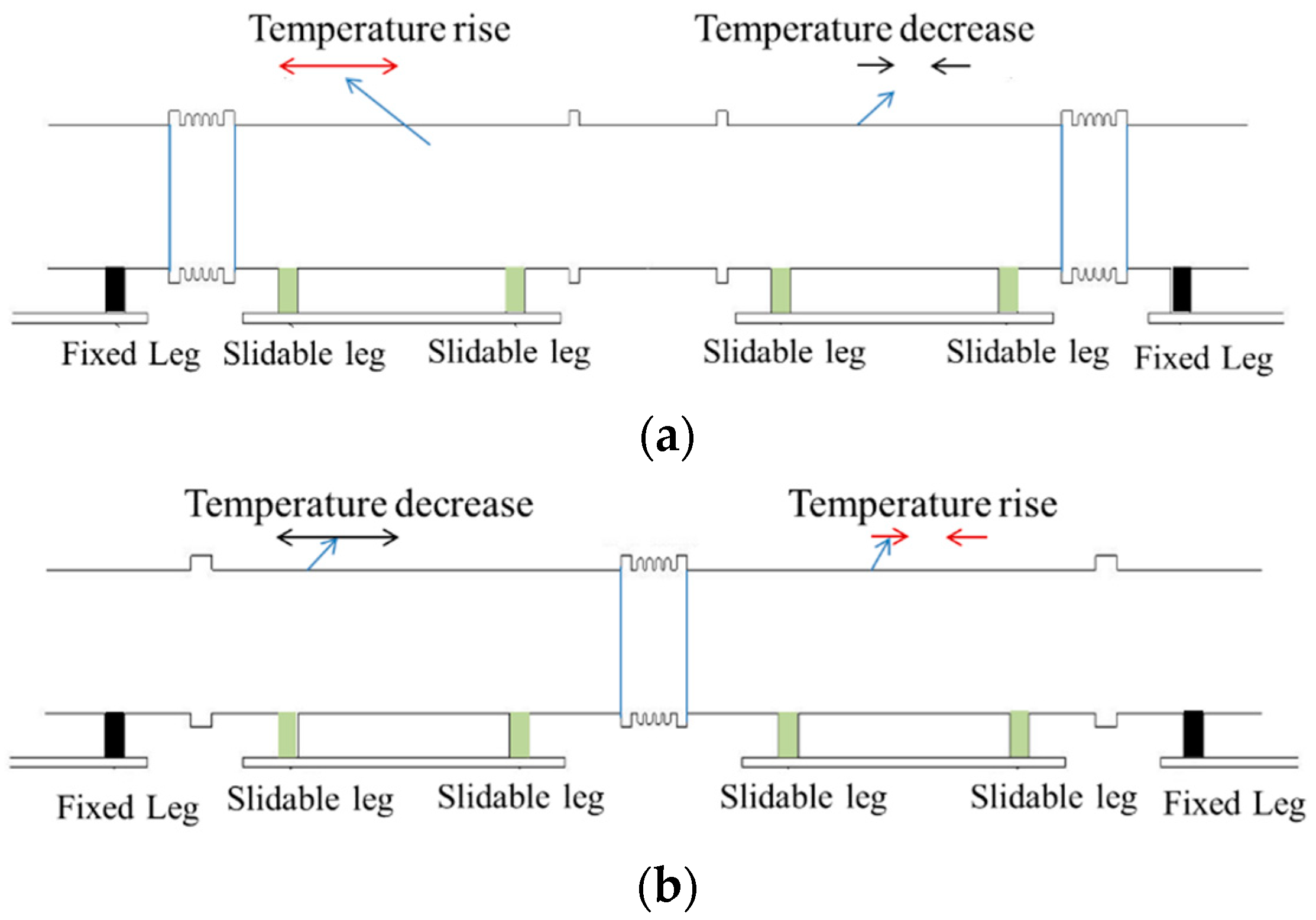


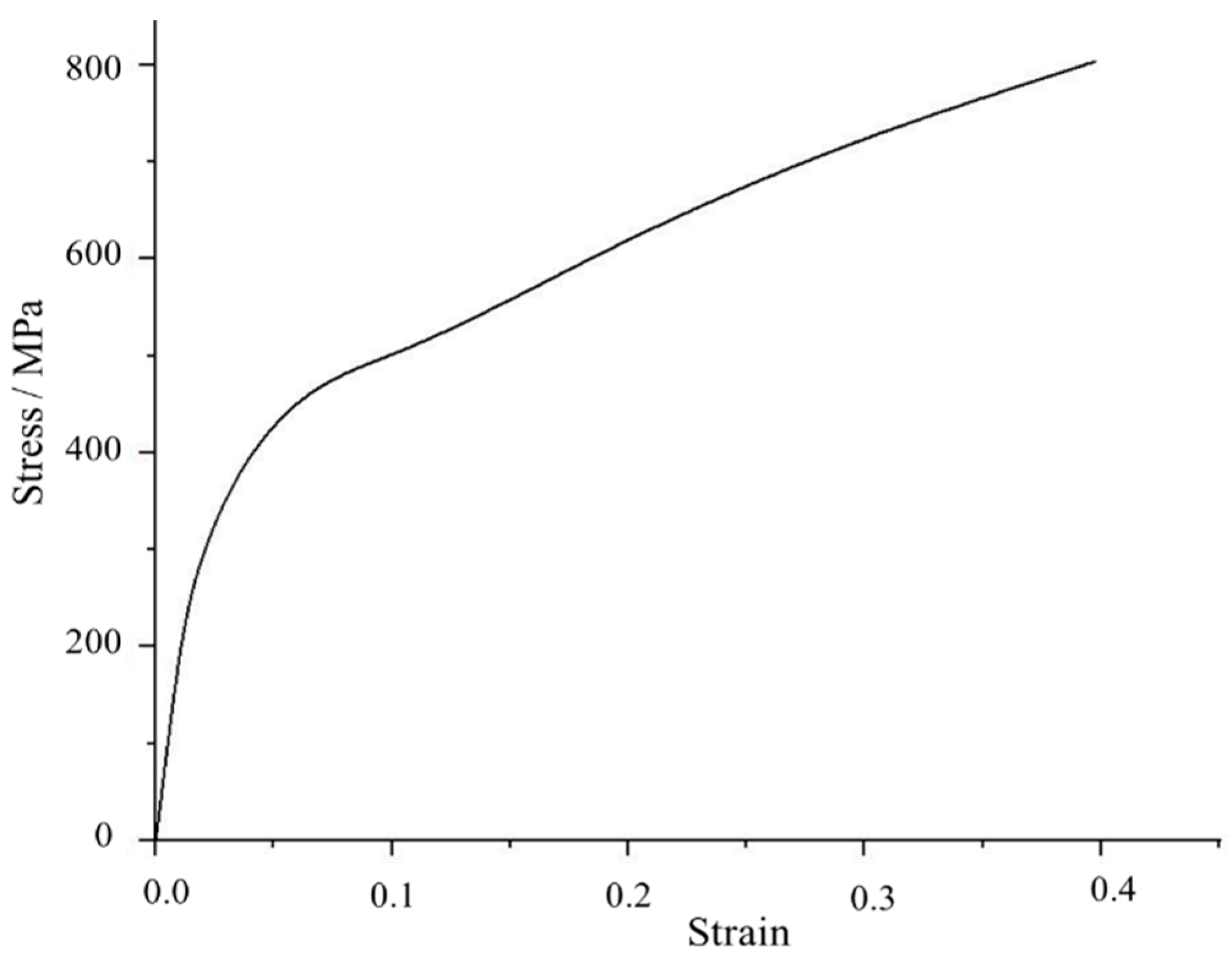
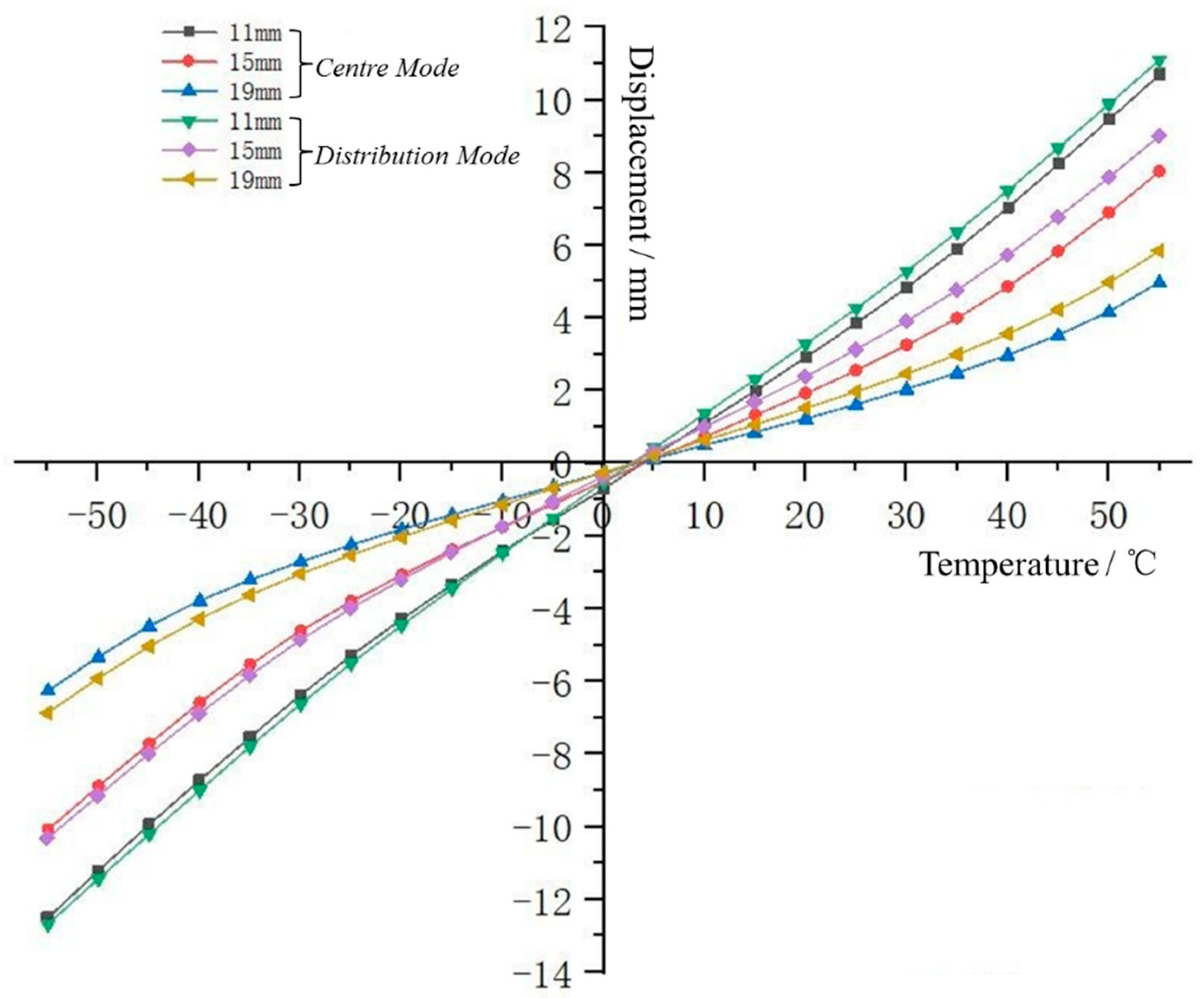
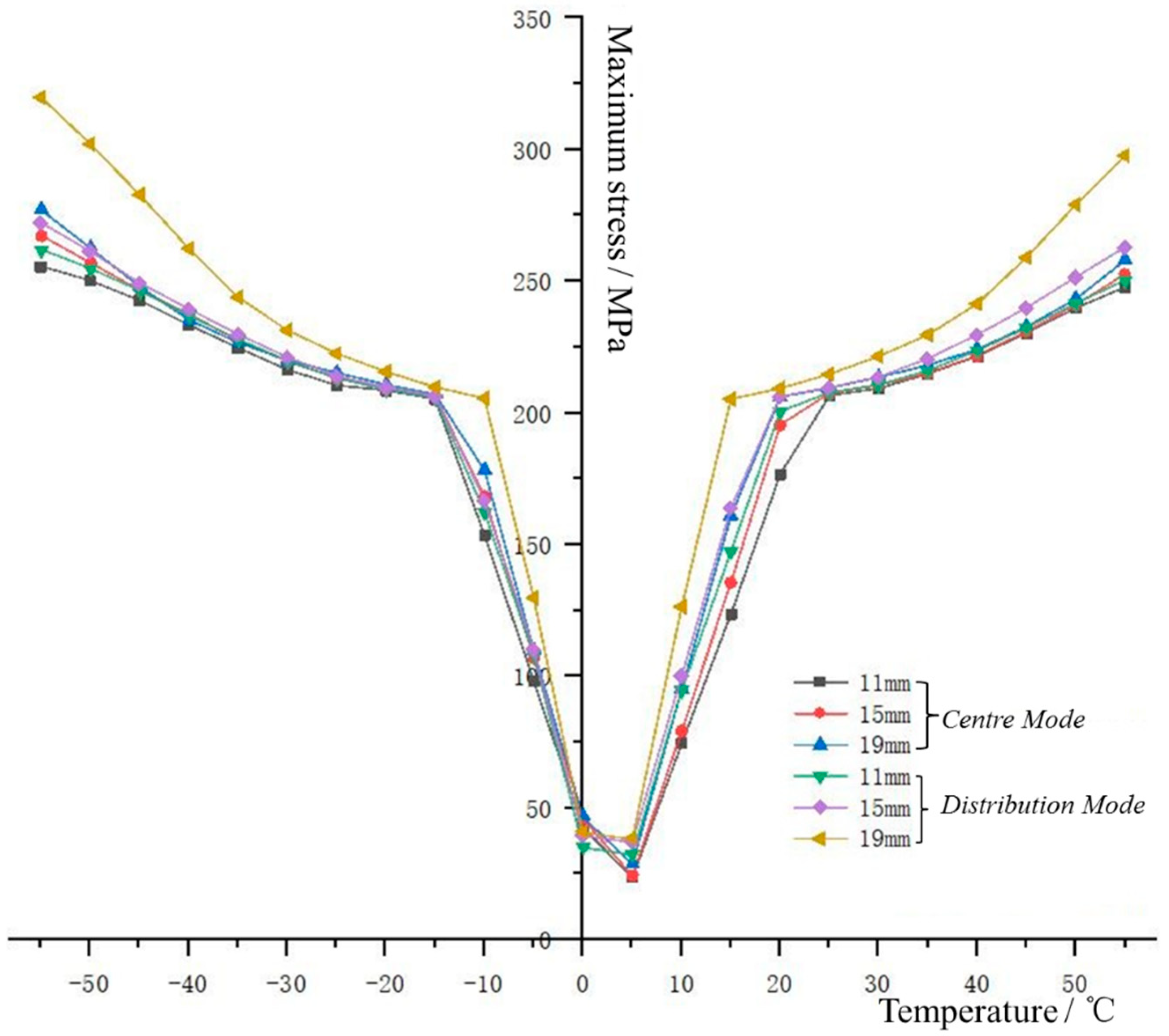

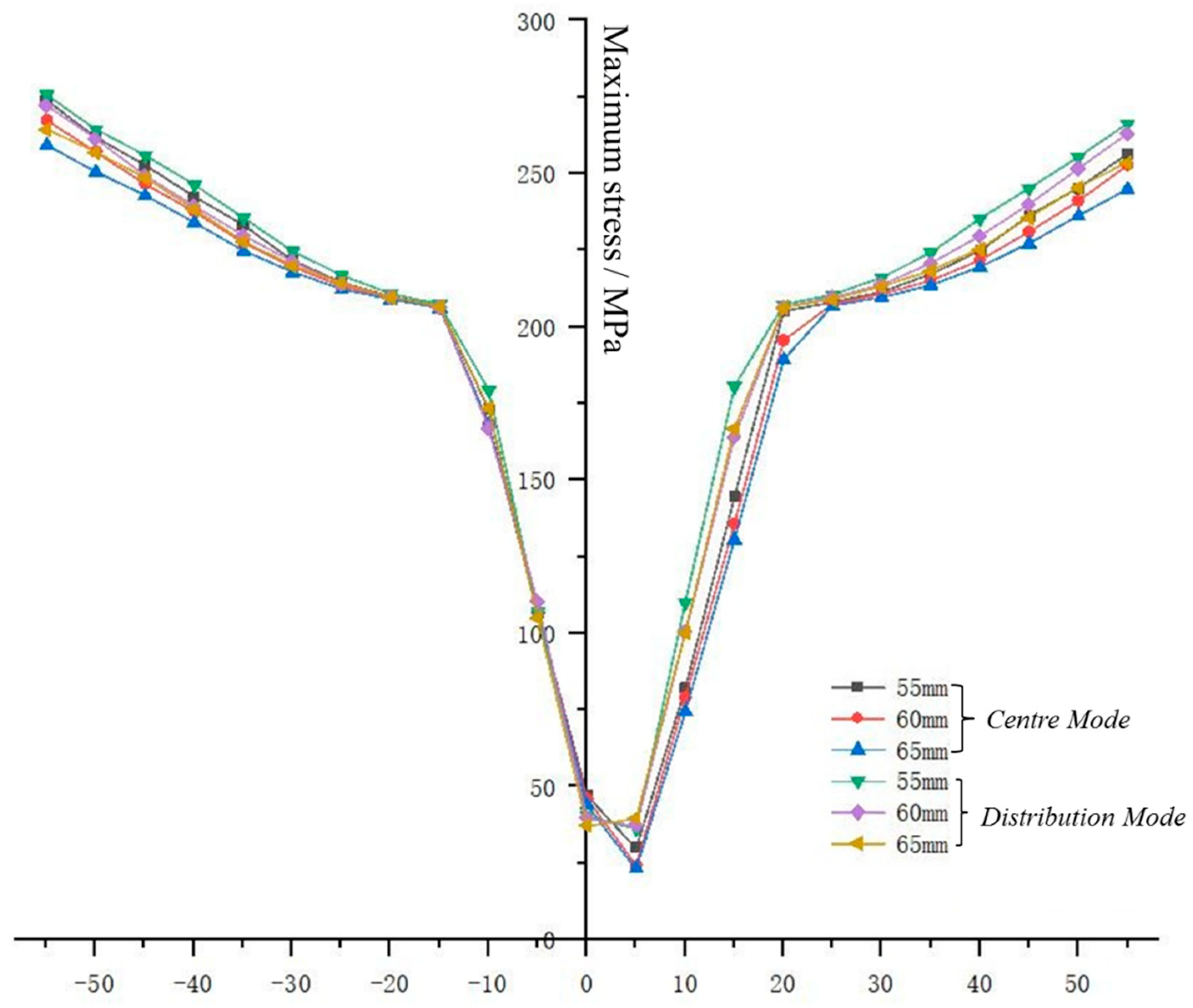

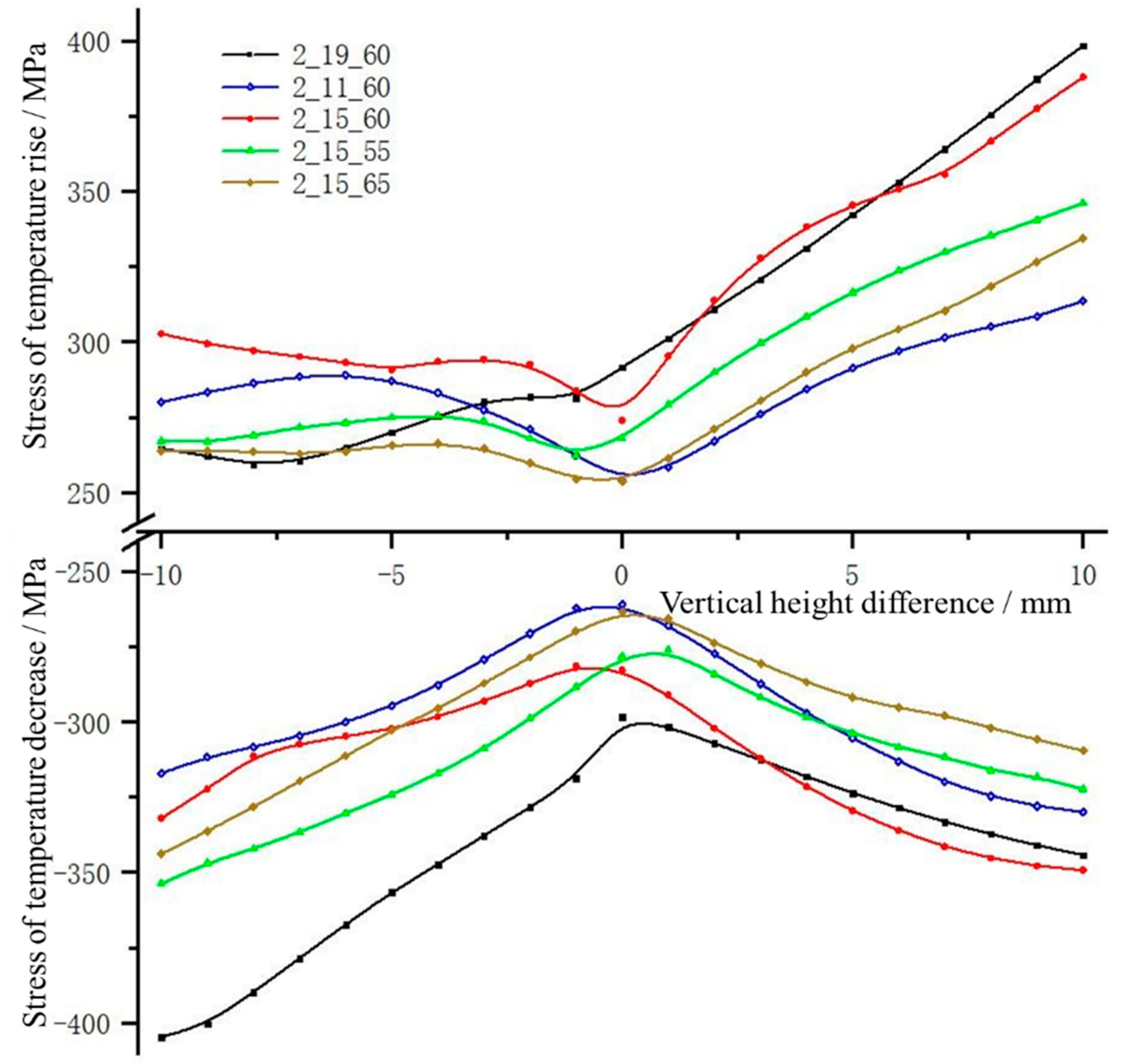
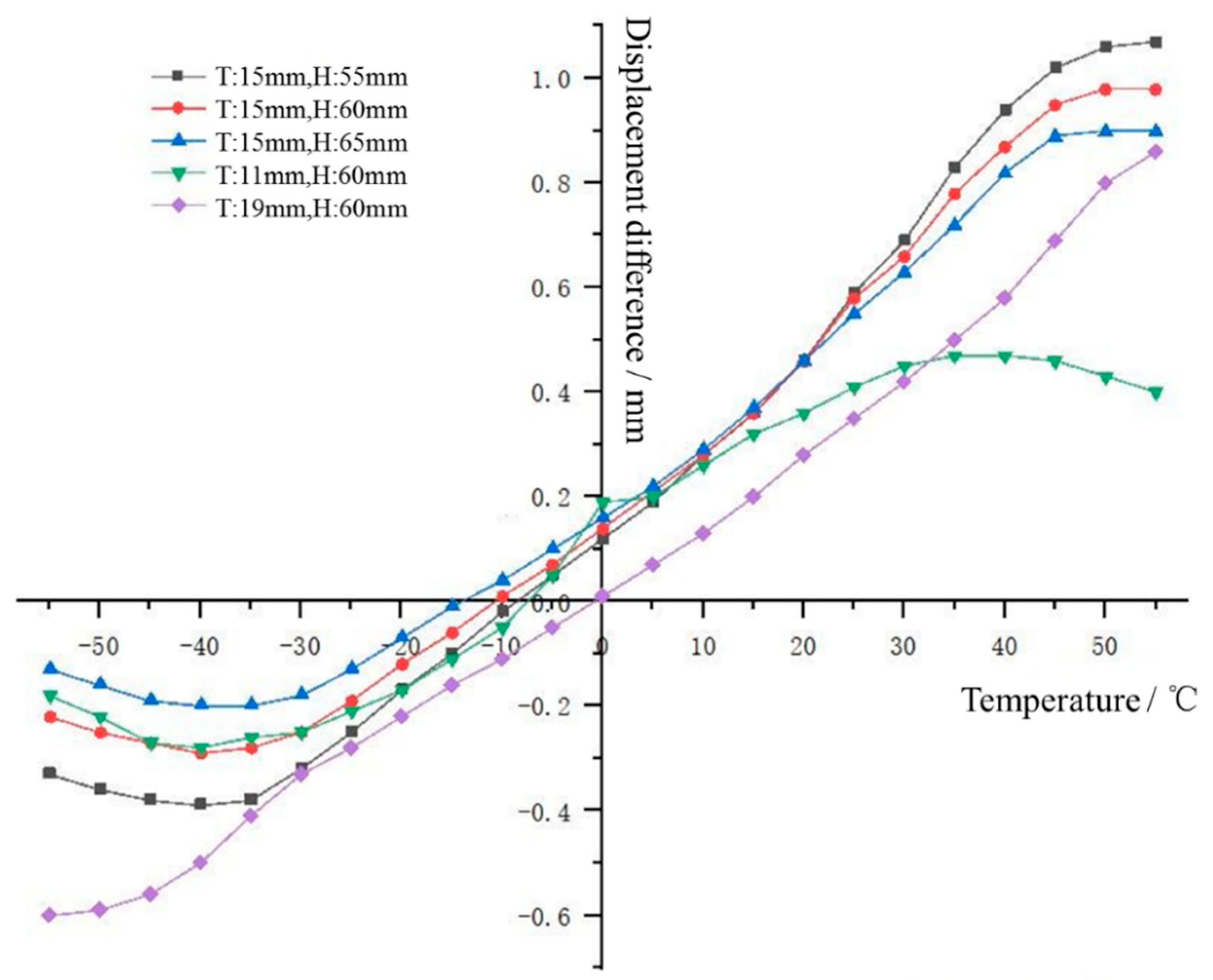
| Part Number | Shell A | Below A | Shell B | Shell C | Shell D | Insulator | Shell E | Shell F | Shell B | Shell G |
|---|---|---|---|---|---|---|---|---|---|---|
| Axial length (m) of distributed layout | 2.835 | 0.416 | 2.601 | 1.399 | 2.605 | 0.142 | 0.268 | 2.568 | 0.416 | 2.649 |
| Axial length (m) of centralized layout | 2.835 | 0.832 | 2.601 | 1.399 | 2.605 | 0.142 | 0.268 | 2.568 | - | 2.649 |
| Position | Material | Modulus of Elasticity N/m2 | Poisson’s Ratio | Density kg/m3 | Coefficient of Thermal Expansion m/°C |
|---|---|---|---|---|---|
| Support leg | Q235 | 2.1 × 1011 | 0.274 | 7830 | 1.2 × 10−5 |
| Base | Q235 | 2.1 × 1011 | 0.274 | 7830 | 1.2 × 10−5 |
| Shell body | ZL114A | 7.0 × 1010 | 0.330 | 2700 | 2.3 × 10−5 |
| Insulator | Epoxy resin | 8.5 × 109 | 0.330 | 980 | 5.9 × 10−5 |
| No. | Bellows Size | R Square | Sum of Squares of Residuals | Tup | Tdown |
|---|---|---|---|---|---|
| 1 | Wall thickness: 11 mm Wave height: 60 mm | 0.97688 | 0.00287 | 88 | −68 |
| 0.9941 | 0.00136 | ||||
| 2 | Wall thickness: 15 mm Wave height: 55 mm | 0.98678 | 0.01783 | 360 | −85 |
| 0.9799 | 0.00731 | ||||
| 3 | Wall thickness: 15 mm Wave height: 60 mm | 0.98733 | 0.01357 | 300 | −76 |
| 0.9821 | 0.00435 | ||||
| 4 | Wall thickness: 15 mm Wave height: 65 mm | 0.98796 | 0.01007 | 240 | −70 |
| 0.9781 | 0.00378 | ||||
| 5 | Wall thickness: 19 mm Wave height: 60 mm | 0.99872 | 0.00114 | 374 | −151 |
| 0.99103 | 0.0046 |
Publisher’s Note: MDPI stays neutral with regard to jurisdictional claims in published maps and institutional affiliations. |
© 2022 by the authors. Licensee MDPI, Basel, Switzerland. This article is an open access article distributed under the terms and conditions of the Creative Commons Attribution (CC BY) license (https://creativecommons.org/licenses/by/4.0/).
Share and Cite
Li, X.; Bi, T.; Xu, H.; Shen, X. Study on Influencing Factors of Temperature Variation Displacement Compensation Behavior of Gas Insulated Switchgear Shell Bellows. Energies 2022, 15, 3954. https://doi.org/10.3390/en15113954
Li X, Bi T, Xu H, Shen X. Study on Influencing Factors of Temperature Variation Displacement Compensation Behavior of Gas Insulated Switchgear Shell Bellows. Energies. 2022; 15(11):3954. https://doi.org/10.3390/en15113954
Chicago/Turabian StyleLi, Xin, Teng Bi, Haiwei Xu, and Xiaojun Shen. 2022. "Study on Influencing Factors of Temperature Variation Displacement Compensation Behavior of Gas Insulated Switchgear Shell Bellows" Energies 15, no. 11: 3954. https://doi.org/10.3390/en15113954
APA StyleLi, X., Bi, T., Xu, H., & Shen, X. (2022). Study on Influencing Factors of Temperature Variation Displacement Compensation Behavior of Gas Insulated Switchgear Shell Bellows. Energies, 15(11), 3954. https://doi.org/10.3390/en15113954






